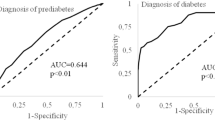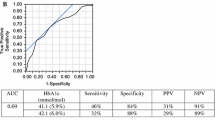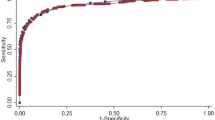Abstract
The objective was to evaluate a screening procedure for detecting high-yield candidates for an OGTT, in a population of middle-aged Swedish women. A two-step screening procedure was performed in 6917 subjects. Women with a positive screening outcome, i.e. increased non-fasting capillary blood glucose, serum triglycerides, BMI, WHR, blood pressure or a family history of diabetes, pharmacological treatment of hypertension or hyperlipidaemia at the primary screening underwent a 75-g OGTT. A control group of women with negative screening outcome (n = 221) also underwent an OGTT. In 2923 women with positive screening outcome, 517 (17.7%) had NFG/IGT (normal fasting venous blood glucose <5.6 mmol/l and 2h-glucose 6.7–9.9 mmol/l), 109 (3.7%) IFG/IGT (fasting 5.6–6.0 and 2h 6.7–9.9 mmol/l) and 223 (7.6%) diabetes (fasting ≥ 6.1 or 2h ≥ 10.0 mmol/l). These figures were three, five and four times higher, respectively, than in the control group with negative screening outcome (p < 0.001 for all); no differences were found for IFG/NGT (fasting 5.6–6.0 and normal 2h < 6.7 mmol/l) (4.6% vs. 7.2%). For predicting impaired glucose metabolism (IFG/NGT, NFG/IGT, IFG/IGT, diabetes), the screening instrument showed an estimated sensitivity of 70%, specificity of 55%, positive predictive value of 34% and negative predictive value of 85%, based on findings in the control sample. The odds ratio for NFG/IGT increased with the numbers of risk factors from 2.8 to 7.7, for IFG/IGT from 5.7 to 55.0 and for diabetes from 2.5 to 18.1. High B-glucose, WHR and BMI were the three most important factors associated with an increased risk for NFG/IGT, IFG/IGT and diabetes. In subjects with IFG/NGT, none of the screening variables was associated with an increased risk. In summary, the results show a population screening method focused on features of the metabolic syndrome that discloses high-yield candidates for OGTT. A high prevalence of unknown impaired glucose metabolism was found in middle-aged women with a positive screening profile.
Similar content being viewed by others
References
King H, Aubert RE, Herman WH. Global burden of diabetes, 1995–2025. Diabetes Care 1998; 21: 1414–1431.
Schantz A, Tuomilehto J, Marti B, Jarrett RJ, Grabauskas V, Vassallo A. Low physical activity and worseningof glucose intolerance: Results from a twoyear follow-up of a population sample in Malta. Diab Res Clin Pract 1991; 11: 127–136.
Zimmet P. Challenges in diabetes epidemiology from West to the Rest. Diabetes Care 1992; 15: 232–252.
Lissner L, Johansson SE, Qvist J, Rossner S, Wolk A. Social mappingof the obesity epidemic in Sweden. Int J Obes Relat Metab Disord 2000; 24: 801–805.
Knowler WC, Narayan KMV, Hanson RL, et al. Preventingnon-insulin-dependent diabetes. Diabetes 1995; 44: 483–488.
Lynch J, Helmrich SP, Lakka TA, et al. Moderately intense physical activities and high levels of cardiorespiratory fitness reduce the risk of non-insulin dependent diabetes mellitus in middle-aged men. Arch Intern Med 1996; 156: 1307–1314.
Eriksson K-F, Lindgärde F. Prevention of Type 2 (noninsulin-dependent) diabetes mellitus by diet and physical exercise. The 6-year Malmöfeasibility study. Diabetologia 1991; 34: 891–898.
Xiao-Ren P, Guang-WEI L, Ying-Hua H, et al. Effects of diet and exercise in preventingNIDDM in people with impaired glucose tolerance, the Da Qing IGT and Diabetes Study. Diabetes Care 1997; 20: 537–544.
Hu FB, Sigal RJ, Rich-Edwards JW, et al. Walking compared with vigorous physical activity and risk of type 2 diabetes in women. JAMA 1999; 282: 433–1439.
Tuomilehto J, Lindström J, Eriksson JG, et al. Prevention of type 2 diabetes mellitus by changes in lifestyle amongsubjects with impaired glucose tolerance. N Engl J Med 2001; 344: 1343–1350.
Alberti KGMM, Zimmet PZ. Definition, Diagnosis and Classification of Diabetes Mellitus and its Complications. Part 1: Diagnosis and Classification of Diabetes Mellitus. Provisional Report of a WHO Consultation. Diabetic Med 1998; 15: 539–553.
Barrett-Connor E. Sex differences in coronary heart disease. Circulation 1997; 95: 252–264.
Bush T. The epidemiology of cardiovascular disease in postmenopausal women. Ann NY Acad Sci 1990; 592: 263–271.
Corrao JM, Becker RC, Ockene IS. Coronary heart disease risk factors in women. Cardiology 1990; 77(Suppl 2): 8–24.
Dahlberg M, Whitelaw A. Evaluation of HemoCue® Blood Glucose Analyzer for instant diagnosis of hypoglycemia in newborns. Scand J Clin Lab Invest 1997; 57: 719–724.
Modan M, Karasik A, Halkin H, et al. Effect of past and concurrent body mass index on prevalence of glucose intolerance and Type 2 (non-insulin dependent) diabetes and on insulin response. Diabetologia 1986; 29: 82–89.
Fontbonne A, Eschwege E, Cambien F, et al. Hypertriglyceridaemia as a risk factor of coronary heart disease mortality in subjects with impaired glucose tolerance or diabetes: Results from the 11-year followup of the Paris Prospective Study. Diabetologia 1989; 32: 300–304.
Boyko EJ, De Courten M, Zimmet PZ, Chitson P, Tuomilehto J, Alberti KGMM. Features of the metabolic syndrome predict higher risk of diabetes and impaired glucose tolerance. Diabetes Care 2000; 23: 1242–1247.
Mokdad AH, Ford ES, Bowman BA, et al. Diabetes trends in the US: 1990–1998. Diabetes Care 2000; 23: 1278–1283.
Andersson DKG, Svêrdsudd K, Tibblin G. Prevalence and incidence of diabetes in a Swedish community 1972–1987. Diabet Med 1991; 8: 428–434.
Harris MI, Flegal KM, Cowie CC, et al. Prevalence of diabetes, impaired fasting glucose and impaired glucose tolerance in US Adults. The third National Health and Nutrition Examination survey, 1988–1994. Diabetes Care 1998; 21: 518–524.
Kuczmarski RJ, Flegal KM, Campbell SM, Johnson CL. Increasingprevalence of overweight among US Adults: The National Health and Nutrition Examination Surveys, 1960–1991. JAMA 1994; 272: 205–211.
Ko GTC, Chan JCN, Tsang LWW, Yeung VTF, Chow CC, Cockram CS. Outcomes of screeningfor diabetes in high-risk Hong Kong Chinese subjects. Diabetes Care 2000; 23: 1290–1294.
Metcalf PA, Scragg RKR. Comparison of WHO and ADA criteria for diagnosis of glucose status in adults. Diabetes Res Clin Pract 2000; 49: 169–180.
Shaw JE, Zimmet PZ, De Courten M, et al. Impaired fasting glucose or impaired glucose tolerance. What best predicts future diabetes in Mauritius? Diabetes Care 1999; 22: 399–402.
Vaccaro O, Ruffa G, Imperatore G, Iovino V, Albarosa Rivellese A, Riccardi G. Risk of diabetes in the new diagnostic category of impaired fasting glucose. Diabetes Care 1999; 22: 1490–1493.
Larsson H, Lindgärde F, Berglund G, Ahrén B. Prediction of diabetes usingADA or WHO criteria in post-menopausal women: A 10-year follow-up study. Diabetologia 2000; 43: 1224–1228.
Gabir MM, Hanson RL, Dabelea D, et al. The 1997 ADA and 1999 WHO criteria for hyperglycemia in the diagnosis and prediction of diabetes. Diabetes Care 2000; 23: 1108–1112.
Tominaga M, Eguchi H, Manaka H, Igarashi K, Kato T, Sekikawa A. Impaired glucose tolerance is a risk factor for cardiovascular disease, but not impaired fastingg lucose. Diabetes Care 1999; 22: 920–924.
Hanefeld M, Temelkova-Kurktschiev T, Schaper F, Henkel E, Siegert G, Koehler C. Impaired fasting glucose is not a risk factor for atherosclerosis. Diabet Med 1999; 16: 212–218.
Suematsu C, Hayashi T, Fujii S, et al. Impaired fasting glucose and the risk of hypertension in Japanese men between the 1980s and the 1990s. Diabetes Care 1999; 22: 228–232.
DECODE study group, on behalf of the European Diabetes Epidemiology Group. Glucose tolerance and mortality: Comparison of WHO and American Diabetes Association diagnostic criteria. Lancet 1999; 354: 617–621.
Engelgau MM, Venkat Narayan KM, Herman WH. Screening for type 2 diabetes. Diabetes Care 2000; 23: 1563–1580.
Blackburn G. Effect of degree of weight loss on health benefits. Obes Res 1995; 3(Suppl 2): 211–216.
Yamanouchi K, Shinozaki T, Chikada K, et al. Daily walkingcombined with diet therapy is a useful means for obese NIDDM patients not only to reduce body weight but also to improve insulin sensitivity. Diabetes Care 1995; 18: 775–778.
Author information
Authors and Affiliations
Rights and permissions
About this article
Cite this article
Lidfeldt, J., Nerbrand, C., Samsioe, G. et al. A screening procedure detecting high-yield candidates for OGTT. The Women's Health in the Lund Area (WHILA) study: A population based study of middle-aged Swedish women. Eur J Epidemiol 17, 943–951 (2001). https://doi.org/10.1023/A:1016291426124
Issue Date:
DOI: https://doi.org/10.1023/A:1016291426124




